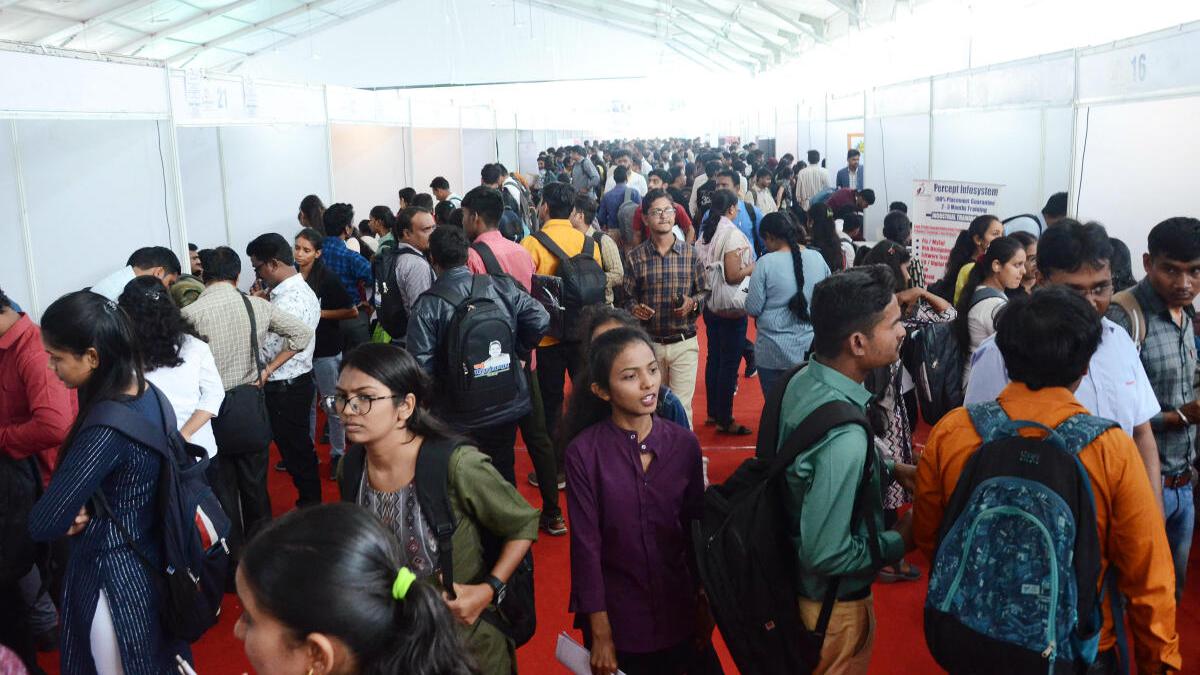
Unemployment amongst youth: Unemployed women and men take part within the Namo Maha Rozgar Melawa program, in Nagpur on Saturday, December 9.
Last Wednesday, two males entered the Lok Sabha and sprayed yellow fuel from canisters, whereas two others stood outdoors Parliament and shouted slogans and sprayed fuel from related canisters. The intruders informed the police that they had been protesting in opposition to the federal government’s incapability to deal with unemployment.
An in depth news report printed in The Hindu said that each one 4 individuals had been both not employed or had been sad about their employment standing. D. Manoranjan, who opened a canister contained in the Lok Sabha, was serving to his father within the sheep-breeding and poultry business after finishing a course in Computer Science Engineering. Sagar Sharma, who accompanied Manoranjan, was compelled to drop out of faculty after greater secondary attributable to his household’s monetary difficulties and was driving an autorickshaw, in line with his mother and father. Neelam Verma, who protested outdoors Parliament, used to speak commonly about unemployment and different points plaguing the poor. Neelam, who holds an M.Phil in Sanskrit, was a authorities job aspirant from Haryana. Her mom stated, “Neelam would often say it is better to die as she could not find a job despite having studied so much.” Amol Shinde, who was with Neelam, had complained to his mother and father that the COVID-19 lockdown had killed his probabilities of moving into the Army. He has been making an attempt to clear the police recruitment examination since then.
Table 1 | The desk exhibits the Labour Force Participation Rate (LFPR), which is the share of the working-age inhabitants which was both working or searching for employment.
T=Total, M=Male, F=Female
Charts seem incomplete? Click to take away AMP mode
A take a look at employment-related indicators printed by the Centre for Monitoring Indian Economy (CMIE) exhibits that they worsened within the post-pandemic interval. In FY23, the general LFPR in India was 39.5%, the bottom since at the very least FY17, together with the pandemic years. Among males, it was 66% and amongst ladies, it was 8.7% — each the bottom since at the very least FY17. So, an rising share of Indians within the working age had been neither employed nor keen to hunt employment even after the pandemic.
“India’s LPR displayed a consistent downward trend in the last seven years. Surprisingly, a bulk of this decline was witnessed before the pandemic itself, with the pandemic only exacerbating the situation,” CMIE wrote in June this yr.
Table 2 | The desk exhibits the unemployment charge (UR), which is the share of unemployed individuals within the labour power. The UR was 7.6% in FY23, greater than pre-pandemic ranges.
T=Total, M=Male, F=Female
Click to subscribe to our Data e-newsletter
The information present that fewer folks of working age had been searching for jobs, of which a comparatively excessive share of individuals had been unemployed.
Table 3 | The desk exhibits the LFPR and UR for all of the quarters ending September between 2016 and 2023. The general LPFR was about 7 proportion factors decrease in 2023 than it was in 2016.
T=Total, U=Urban, R=Rural
This development continued even when the newest obtainable quarter-wise information was thought of. Moreover, the general LFPR was barely decrease than the quarters ending September 2020 and September 2021 (7.3% every) — the pandemic-affected intervals. More importantly, the UR within the quarter ending September 2023 was 8.1%, a lot greater than what it was within the quarters ending September 2020 and September 2021 (7.3% every).
Table 4 | The desk exhibits the LFPR and UR for all of the November months between 2019 and 2023.
T=Total, U=Urban, R=Rural
This development continued even when the newest obtainable month-wise information was thought of. The UR was as excessive as 9.2% in November 2023, over one level greater than any November since 2019, together with the pandemic months. These figures present that India is within the grip of a persistent unemployment drawback.
Source: The tables are based mostly on the information collected from the Centre for Monitoring Indian Economy
Also learn: How unemployment is measured
Listen to our Data podcast: Examining the 70-Hour Work Week: Insight or Imposition by Infosys’ Narayana Murthy | Data Point podcast
Source: www.thehindu.com



